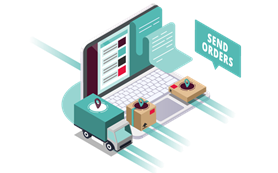
Order Management Systems: A Comprehensive Glossary of Terms & Features
You may have heard about the benefits of order management and warehouse management systems. From providing comprehensive, real-time visibility of all your orders and warehouse operations, to automating time-consuming manual tasks, these solutions help you and your staff simplify fulfilment, save significant time and reduce costs.
If you are currently researching order management and warehouse management solutions, there is a good chance you will encounter many new software terms and features you may not have heard of.
Here at Mintsoft we will provide you an extensive glossary of the most important terms with definitions, so you can fully understand the functionalities offered by fulfilment software.
Make sure to bookmark this page so you can quickly understand any features or concepts you come across while researching potential solutions.
 10 min
10 min
Written by The Access Group
A - B - C - D - E - F - G - H - I - J - K - L - M - N - O - P - Q - R - S - T - U - V - W - X - Y - Z
A
Automated email alerts
An email automatically sent to you when a customer orders a product. You will also be notified of the order via your dashboard, helping ensure you do not miss any orders or must repeatedly check for new orders.
ASNs
To help monitor all your incoming deliveries, you can create an Advanced Shipping Notification (ASN) once you have finalised a shipment or purchase with a supplier. This simplifies your processes by allowing you to receive stock according to expiry date or batch/serial number.
Alternate SKU mapping across channels
An order management system allows you to map different product codes (SKUs) for the same product across multiple sales channels. This is helpful if you are not able to maintain the same product code for a single product, which often leads to mistakes when importing products. For instance, you can create specific product codes for eBay, Groupon or another sales channel.
Add packing and packaging instructions to products
With an order management system, you can create messages for your staff instructing them on the best way to pack and package an order. You can assign instructions for a particular product, so that each product has the same instructions. Or you can assign instructions based on the client, so that all their orders are packed and packaged the same. Staff automatically receive the instructions message when a product is at the dispatch stage.
Automatic release of batches/pickwaves
This is helpful when you need to delay an order because a customer or fulfilment partner is not yet ready to receive it. For instance, if a retailer has set a particular delivery date to receive your order. This means you can cater to the specific needs of the receiving partner and minimise shipping delays when processing backorders.
Auto exchange option on return
This feature allows you to better service customers or fulfilment partners if they have requested an order exchange. It gives you the ability to customise the order to include additional items or more of the same item, as well as alter the delivery address.
Audit of client activity against products and orders
This makes it simpler to make sense of all your customer or fulfilment partner data, allowing you to focus on the activity of a single client.
B
Booking inventory in
If you need to accommodate last-minute alterations, an order management system provides a simple way to book inventory into particular warehouses or storage locations.
Batch creation
This feature is especially helpful if you sell perishable items with expiry dates or follow a first in, first out approach for your inventory. It makes it possible to attach a unique batch number to groups of items with the same SKU.
Bulk order updates
If you need to update numerous orders with the same action, this feature eliminates the time-intensive manual process of having to update each order individually. For example, if multiple orders have been received with no weight assigned to them, you can update them all in one go.
Back-order rules
This feature allows you to define certain default rules for handling orders that cannot be fulfilled due to lack of stock. These rules can be customised for individual customers or fulfilment partners to meet their individual needs and preferences.
C
API integrations for couriers and multi-carriers
Leading order management systems offer pre-built integrations with courier management and multi-carriers, allowing you to simplify the management of third-party services as well as gain more control and visibility of your shipping processes.
Cloud-based
The future of any software solution, let alone order management systems, is in the cloud. Cloud-based solutions provide countless benefits over traditional on-premises platforms, including access from anywhere with an internet connection as well as automatic functionality and security updates. They also remove the need for costly private servers or IT maintenance.
Customisable dashboard
Enhanced visibility of your fulfilment processes is a key benefit of order management systems, which provide intuitive dashboards that you can customise. You can remove standard modules or add new ones to gain the data insights you need, with the ability to create personalised dashboards for specific staff members.
Client currency charging
If you are selling overseas, this feature gives you the ability to provide customers with invoices with prices in their currency. This make life easier for them and means you will get paid faster.
Custom reports
The ability to create custom reports featuring your business’s branding is a key benefit of modern cloud-based software. You can quickly and easily create documents like packing slips, picking lists and invoices with your logo to help get your brand out there.
D
Dropshipping capabilities
You can eliminate manual processes and simplify dropshipping by using a cloud-based order management system. They provide specific functionality that allows you to easily designate orders to be processed by a third-party. You can create a list of dropship products and suppliers, which the system will automatically separate from orders that you will process yourself. It will then automatically email the supplier to process your order.
Default pick locations
This warehouse management system feature allows you to boost efficiency by defining locations for the picking and packing of multiple SKUs. It allows you to define and update locations in bulk and easily process actions like the placement, transfer and replenishment of stock.
E
Ecommerce management
Cloud-based order management systems provide powerful features that help you gain more control and visibility over your ecommerce operations. These solutions boast integrations with third-party ecommerce platforms, allowing you to manage everything in one place. They can also automate many manual tasks and simplify the process of ensuring accurate inventory levels.
Export order data
This feature is helpful when you need to generate a report based on detailed data for numerous orders. When exporting data, you have the option to select particular fields of data like addresses, for instance. You can also specify the order in which these fields will feature in the report.
F
Financials
A challenge for many ecommerce businesses is having to manage multiple unintegrated platforms; for instance, an order management solution and a separate accounting or financial software. Having both these platforms integrated in a single solution simplifies financial management and removes many time-intensive manual processes.
Fulfilment
Automating and gaining real-time visibility of your fulfilment processes is key to meeting the growing demands of today’s customers. Boasting powerful automation capabilities, cloud-based fulfilment platforms help you boost efficiency across warehouse, inventory and order management plus offer advanced data analytics and reporting capabilities to track performance.
G
Goods in/goods out
Receiving inventory in your warehouse is a process you want to make as accurate and seamless as possible. The right warehouse management system makes it simple with automated processes and real-time insights. And when goods are on their way out, the system can automatically update your inventory levels across all your channels.
H
High level overview
This form of visibility helps you keep track of your end-to-end fulfilment operations. Leading order management solutions give you a high level overview via intuitive dashboards that you can customise for key metrics, so you can ensure multiple parts of your business are performing.
Highest point location type charging
This feature helps you maximise storage revenue from fulfilment partners. For a given storage period, an order management system will select the maximum storage point. For instance, if your fulfilment partner has a weekly storage period, the system will identify the day that the maximum storage point was hit across all locations. It will then avail this information to charge the partner.
I
Integrations
Consolidating all your key fulfilment functions into a single solution makes life a lot easier. It means you can manage all your orders from a central hub and no longer have to log into multiple software solutions. When considering a fulfilment system, ensure that it has API capabilities so you can customise integrations for other software solutions and third-party applications.
Inventory management
This is a key capability offered by order and warehouse management solutions that helps simplify stock management, provides real-time visibility of all stock movements and availability, plus allows you to automate manual processes to save time.
Invoicing
You can make accessing and paying invoices far simpler for your clients, with the ability to upload invoices to a portal. Clients can view the invoice in the portal or download it as PDF, while you can easily make changes to it if needed.
J
Job configuration
Via batch scheduling functionality, you can configure jobs to automatically create batches with a pre-built template. You can also set a particular schedule for batch creation.
K
Kit building
Order management software can save you significant time by automating kitting. This feature allows you to group complementary products together in a kit. Once you have chosen which products to include, they are immediately allocated to in bulk. The system will also allow you to view the costs of your kit. Building a kit of products, otherwise known as a bill of materials, is particularly helpful for manufacturers to minimise overhead expenses and boost repeat sales.
L
Low stock alerts
An automated alert that is triggered when your inventory level falls below a certain threshold. With this feature, you are always kept up to date on your available stock and it helps you ensure customers never order an out-of-stock product.
Linked product rules
This allows you to automatically include additional items in an order when specific conditions are met. For instance, adding free light bulbs when a specific lamp is ordered. Or including a voucher when an order exceeds $50.
M
Mobile barcode scanning
Cloud software can allow you to use a mobile device as a barcode scanner to enhance efficiency and accuracy across multiple aspects of your fulfilment process. For instance, mobile barcode scanning can be used during the picking and packing process to enhance accuracy. Or it can be used to scan items delivered to your warehouse to ensure all your inventory is accurate and up to date.
Master carton barcodes
You do not need to individually scan each unit within a carton when using an order management system. If a carton features a barcode, you can enter it into the system and assign individual units to it. This means that when you scan the carton’s barcode, all items within are entered into the system.
Merge orders
Cloud-based fulfilment software makes it quick and easy to merge two orders for the same customer into one.
Miscellaneous or ad-hoc charges
It only takes a few clicks to update a customer’s invoice with additional charges like, for instance, the cost of pallet storage or labour charges.
Multi-tote picking
This approach to order picking helps save significant time and involves picking orders with multiple items simultaneously. To do this, it is recommended that you use a picking trolley with several totes, each with their own colour. This makes it easier for warehouse personnel to know which tote to put items into.
Marketplaces
Managing your orders across multiple marketplaces like Amazon and eBay is often challenging. Not only do you need to track orders across each separate marketplaces, but you are also forced to perform a significant number of manual tasks. Multi-channel listing software solves these problems as it can integrate all your marketplaces into one central platform. It provides end-to-end visibility of all your orders across all marketplaces, removes many time-sapping tasks and even updates your inventory in real-time.
N
Non-conformance records
You can create a non-conformance record to document and monitor product-specific discrepancies. When required, this feature also allows you to record follow-up activities and approvals.
O
Order management
Order management is the process of capturing, tracking, and fulfilling customer orders based on customer’s specifications and delivering goods as promised at the time of sale. These features help streamline your end-to-end processes, providing the real-time visibility and insights needed to constantly improve service levels. Plus, the latest solutions offer automation capabilities that help you fulfil orders more efficiently, accurately and consistently.
Open API
An open Application Programming Interface (API) is a feature of leading order management systems that allows you to create customised integrations with particular digital platforms. This is a very handy feature to have as it means you can consolidate multiple disparate software solutions into a central platform. This helps remove manual processes and the pain of working across different solutions.
Omnichannel
An approach to ecommerce that involves selling products across a variety of different sales channels, like bricks-and-mortar stores, a website or marketplaces. By providing a consolidated view and control of all your sales channels in one platform, an order management system removes the complexity and manual processes typically required with omnichannel selling.
P
Product warehouse allocation
This is a helpful feature if, for example, you want to transfer inventory to a warehouse located in an area experiencing more demand. With a cloud-based fulfilment solution, you can easily prioritise the warehouse for inventory allocation.
Product bundles
An effective way for businesses to sell low-selling products is to bundle them with other products. This increases the order size and helps promote low-selling products without the need to drop prices. Product bundling also enables efficient stock management as an order management system can separate bundled items by product codes. This means you do not need to manually transfer items in and out using separate codes.
Picking costs
Cloud-based fulfilment software can help you streamline invoicing by offering different ways to calculate the costs of picking, including by the quantity of items.
Process returns
An order management solution can help simplify the process of returning orders to customers, helping you eliminate manual tasks and save significant time. If you received the returned order with the dispatch note, all you need to do is scan the barcode to return the order. If the note was not included, you can complete the return by searching for the order in the system by the order number, name or post code. The solution will also automatically update your stock immediately.
Q
Query management
A querying system is a critical software feature that allows communication between your business and customers in the event of order issues. This allows customers or warehouse personnel to swiftly raise issues and therefore correct order mistakes.
Quantity rules
These allow you to automatically calculate the volume of parcel quantities prior to the packing of orders. For instance, you can calculate the parcel quantity for a particular courier based on the order weight. This could look like: total order weight = 60KG, Courier is Parcelforce = 2 parcels.
R
Replenishment reporting
This helps ensure warehouse staff will always have adequate stock in picking locations. You can set up replenishment reporting that triggers updates when your stock level in a specific location falls below a certain threshold. You can also enable a replenishment action to move inventory in bulk between warehouse locations.
Recurring billing items
You can streamline customer billing and save significant time and effort by setting up automated invoices that can be sent daily, weekly or monthly.
Reporting suite
Order management systems allow you to create customised reports for key metrics like picking and packing accuracy or stock receiving efficiency. You can even set up rules so that when you generate a report, it is sent to specific staff members at a defined time.
S
Stock movement management
Using software, you can stay on top of all your inventory moving in and out with stock flow data reports. You can customise a report for transactions relating to a specific product and set up automated email notifications for staff members.
Subscription products
You can easily create subscription rules for products using an order management system. All you need to do is input the SKU for the product that is to be made into a subscription, then add the timeframe and frequency of the subscription.
Shipping management
This feature automatically selects courier services based on rules you define. You can enter in key selection criteria to ensure the quickest, most efficient and highest quality services are automatically prioiritised.
Shopping carts
The best fulfilment solutions seamlessly connect with shopping carts like Shopify or Magento. They consolidate multiple shopping carts in a single platform, allowing you to simplify orders, inventory management and accounting tasks.
T
Transfer inventory
This feature makes it easy to transfer stock to a different location in your warehouse or to another warehouse. This comes in handy when, for instance, you need to move inventory from a low demand to a high demand warehouse.
Third Party Logistics (3PL)
This is when a business outsources its ecommerce logistics to a third-party provider. Leading order management or warehouse management systems 3PL management by automating manual tasks and providing visibility across your warehouse, inventory and courier processes.
U
User-friendly dashboard
This makes using software far simpler for you and your team. They will require far less assistance to learn how to use the solution if its dashboards and user-interface are intuitive.
V
Voice assisted picking commands
This is an effective alternative to using printed pick and pack lists. Pickers are equipped with a microphone headset connected to a mobile computer, as well as a barcode scanner. The mobile computer receives data from a warehouse management system, which then issues verbal instructions to pickers on where and what to pick. Pickers can then provide verbal feedback, which is received by the mobile computer’s voice-recognition capabilities.
W
Warehouse management
A warehouse management system is a software solution used by warehouse operators and third-party logistics providers to manage inventory and warehouse processes. Leading solutions provide powerful automation that eliminates manual tasks and streamlines the fulfilment process – from receiving stock to picking and packing orders.
Wave picking
Also known as cluster picking, this is a picking strategy where you release specific orders to the warehouse floor for processing based on a common factor. This can include the type of product, courier method, channel or shipping date. Products are released in waves throughout the day, which means that large quantities of orders can be fulfilled together, making the process far more efficient by performing tasks like printing courier labels in bulk.
Wireless printing picking options
Using a cloud-based fulfilment solution means you can easily connect to a wireless printer. This provides a quicker and easier way to print courier labels as the printer can be moved to wherever is most convenient in your warehouse.
X
X-border ecommerce
A strategy that allows retailers to sell products to a global customer base by utilising international marketplaces or the website of a foreign retailer. Cross-border ecommerce helps you tap into a much wider potential customer base, increase year-round sales and boost your brand globally. Fulfilment software makes this global approach easy by offering integration with global marketplaces and couriers, as well as providing pre-built templates to create customs documents.
X-Channel Management
Many fulfilment businesses leverage the strategy of selling a single product on a number of different marketplaces simultaneously. Known as Cross-channel or multi-channel management, this approach allows you to drive revenue from several channels and tap into multiple customer bases.
Y
YoY
An order management system makes it simple for fulfilment businesses to assess their Year-on-Year growth as they provide powerful data analytics capabilities. Using intuitive dashboards, you can compare performance over multiple years by drilling down into key metrics about your orders, including the volume received and dispatched, order sources and many other metrics.
Z
Zero-inventory
Typically used by manufacturers, this is a strategy designed to reduce costs and optimise warehouse space by holding as little inventory as possible. The ultimate aim is for a business to only order and hold the items it has forecasted to sell over a particular time frame. Because order management systems provide real-time visibility and automatic updates, it can help you project your stock needs so that you can utilise a zero-inventory approach.
Zone picking and consolidation
This involves segregating SKUs into separate zones to help increase picking efficiency, with warehouse staff assigned to pick within specific zones. Cloud-based fulfilment software makes it easy to facilitate zone picking as it provides comprehensive visibility of your warehouse operations and inventory.
What to look for in your next Order Management System
Whether you’re looking to invest in an OMS for the first time, or looking to upgrade your existing system, we hope some of the order management terminology we have explored helps you cut through the jargon and understand the full capabilities of the software.
If you’d like to learn more about Mintsoft and its OMS capabilities, see the platform in action with our 4-min product tour or book to speak to one of our experts for a personalised live demo.
CASE STUDY | How Black Bear Fulfillment benefited from Mintsoft OMS
Black Bear Fulfillment have a simple mission: To provide the high levels of fulfillment service to Australian customers, which they experienced as a former eCommerce seller in the US and UK. An eCommerce 3PL specialising in smaller consumer items, such as clothing and cosmetics, Black Bear Fulfillment are 100% Australian owned and operated. They are based in Melbourne and employ more than 40 people after launching just three years ago.
Unlike most 3PL’s they aren’t just focused on the logistics and warehousing side of the business, but also, importantly, the customer. Fulfillment is about people as much as it is logistics, and they needed a software solution to help bring this customer-centric vision to life.
 Case Study
Case Study
Read the Black Bear Fulfillment case study to learn more about how this Australian 3PL has leveraged the power of the Mintsoft solution to grow their business and deliver a world-class customer experience.
Want to know more?
Have a read through more order management resources, guidance and advice.




